Lu Cheng
Shakespearean Sparks: The Dance of Hallucination and Creativity in LLMs' Decoding Layers
Mar 04, 2025Abstract:Large language models (LLMs) are known to hallucinate, a phenomenon often linked to creativity. While previous research has primarily explored this connection through theoretical or qualitative lenses, our work takes a quantitative approach to systematically examine the relationship between hallucination and creativity in LLMs. Given the complex nature of creativity, we propose a narrow definition tailored to LLMs and introduce an evaluation framework, HCL, which quantifies Hallucination and Creativity across different Layers of LLMs during decoding. Our empirical analysis reveals a tradeoff between hallucination and creativity that is consistent across layer depth, model type, and model size. Notably, across different model architectures, we identify a specific layer at each model size that optimally balances this tradeoff. Additionally, the optimal layer tends to appear in the early layers of larger models, and the confidence of the model is also significantly higher at this layer. These findings provide a quantitative perspective that offers new insights into the interplay between LLM creativity and hallucination. The code and data for our experiments are available at https://github.com/ZicongHe2002/HCL-Spark.
DBR: Divergence-Based Regularization for Debiasing Natural Language Understanding Models
Feb 25, 2025Abstract:Pre-trained language models (PLMs) have achieved impressive results on various natural language processing tasks. However, recent research has revealed that these models often rely on superficial features and shortcuts instead of developing a genuine understanding of language, especially for natural language understanding (NLU) tasks. Consequently, the models struggle to generalize to out-of-domain data. In this work, we propose Divergence Based Regularization (DBR) to mitigate this shortcut learning behavior. Our method measures the divergence between the output distributions for original examples and examples where shortcut tokens have been masked. This process prevents the model's predictions from being overly influenced by shortcut features or biases. We evaluate our model on three NLU tasks and find that it improves out-of-domain performance with little loss of in-domain accuracy. Our results demonstrate that reducing the reliance on shortcuts and superficial features can enhance the generalization ability of large pre-trained language models.
Understanding the Uncertainty of LLM Explanations: A Perspective Based on Reasoning Topology
Feb 24, 2025Abstract:Understanding the uncertainty in large language model (LLM) explanations is important for evaluating their faithfulness and reasoning consistency, and thus provides insights into the reliability of LLM's output regarding a question. In this work, we propose a novel framework that quantifies uncertainty in LLM explanations through a reasoning topology perspective. By designing a structural elicitation strategy, we guide the LLMs to frame the explanations of an answer into a graph topology. This process decomposes the explanations into the knowledge related sub-questions and topology-based reasoning structures, which allows us to quantify uncertainty not only at the semantic level but also from the reasoning path. It further brings convenience to assess knowledge redundancy and provide interpretable insights into the reasoning process. Our method offers a systematic way to interpret the LLM reasoning, analyze limitations, and provide guidance for enhancing robustness and faithfulness. This work pioneers the use of graph-structured uncertainty measurement in LLM explanations and demonstrates the potential of topology-based quantification.
COPU: Conformal Prediction for Uncertainty Quantification in Natural Language Generation
Feb 18, 2025Abstract:Uncertainty Quantification (UQ) for Natural Language Generation (NLG) is crucial for assessing the performance of Large Language Models (LLMs), as it reveals confidence in predictions, identifies failure modes, and gauges output reliability. Conformal Prediction (CP), a model-agnostic method that generates prediction sets with a specified error rate, has been adopted for UQ in classification tasks, where the size of the prediction set indicates the model's uncertainty. However, when adapting CP to NLG, the sampling-based method for generating candidate outputs cannot guarantee the inclusion of the ground truth, limiting its applicability across a wide range of error rates. To address this, we propose \ourmethod, a method that explicitly adds the ground truth to the candidate outputs and uses logit scores to measure nonconformity. Our experiments with six LLMs on four NLG tasks show that \ourmethod outperforms baseline methods in calibrating error rates and empirical cover rates, offering accurate UQ across a wide range of user-specified error rates.
Large Vision-Language Model Alignment and Misalignment: A Survey Through the Lens of Explainability
Jan 02, 2025Abstract:Large Vision-Language Models (LVLMs) have demonstrated remarkable capabilities in processing both visual and textual information. However, the critical challenge of alignment between visual and linguistic representations is not fully understood. This survey presents a comprehensive examination of alignment and misalignment in LVLMs through an explainability lens. We first examine the fundamentals of alignment, exploring its representational and behavioral aspects, training methodologies, and theoretical foundations. We then analyze misalignment phenomena across three semantic levels: object, attribute, and relational misalignment. Our investigation reveals that misalignment emerges from challenges at multiple levels: the data level, the model level, and the inference level. We provide a comprehensive review of existing mitigation strategies, categorizing them into parameter-frozen and parameter-tuning approaches. Finally, we outline promising future research directions, emphasizing the need for standardized evaluation protocols and in-depth explainability studies.
Unveiling Performance Challenges of Large Language Models in Low-Resource Healthcare: A Demographic Fairness Perspective
Nov 30, 2024Abstract:This paper studies the performance of large language models (LLMs), particularly regarding demographic fairness, in solving real-world healthcare tasks. We evaluate state-of-the-art LLMs with three prevalent learning frameworks across six diverse healthcare tasks and find significant challenges in applying LLMs to real-world healthcare tasks and persistent fairness issues across demographic groups. We also find that explicitly providing demographic information yields mixed results, while LLM's ability to infer such details raises concerns about biased health predictions. Utilizing LLMs as autonomous agents with access to up-to-date guidelines does not guarantee performance improvement. We believe these findings reveal the critical limitations of LLMs in healthcare fairness and the urgent need for specialized research in this area.
From Generation to Judgment: Opportunities and Challenges of LLM-as-a-judge
Nov 25, 2024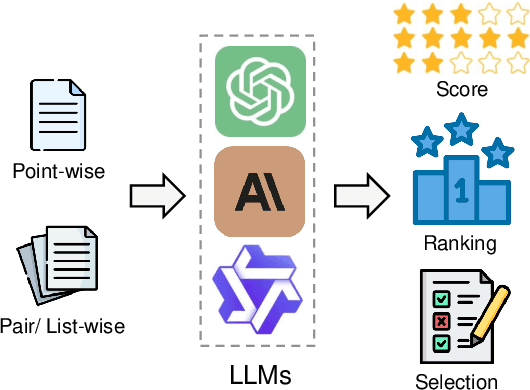
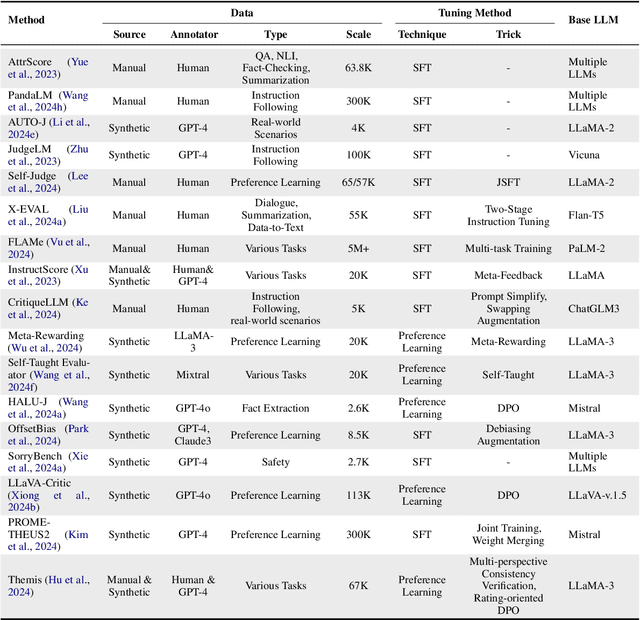
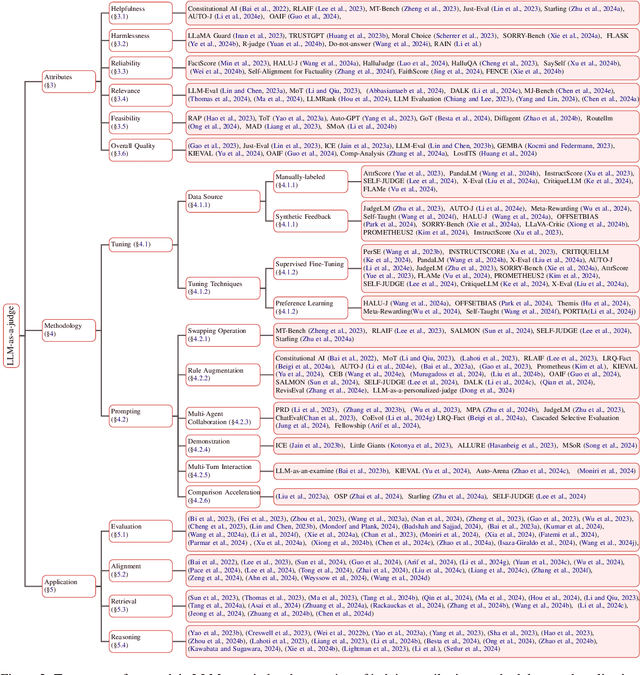
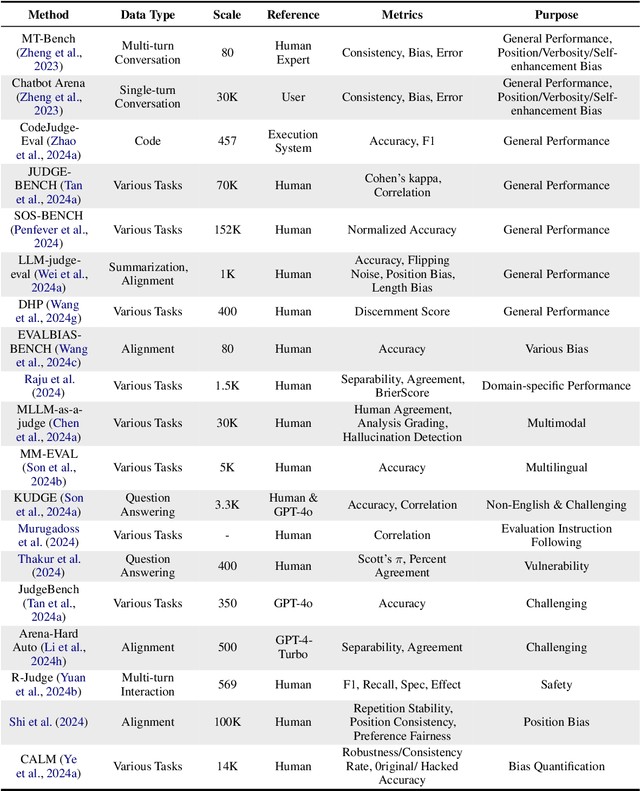
Abstract:Assessment and evaluation have long been critical challenges in artificial intelligence (AI) and natural language processing (NLP). However, traditional methods, whether matching-based or embedding-based, often fall short of judging subtle attributes and delivering satisfactory results. Recent advancements in Large Language Models (LLMs) inspire the "LLM-as-a-judge" paradigm, where LLMs are leveraged to perform scoring, ranking, or selection across various tasks and applications. This paper provides a comprehensive survey of LLM-based judgment and assessment, offering an in-depth overview to advance this emerging field. We begin by giving detailed definitions from both input and output perspectives. Then we introduce a comprehensive taxonomy to explore LLM-as-a-judge from three dimensions: what to judge, how to judge and where to judge. Finally, we compile benchmarks for evaluating LLM-as-a-judge and highlight key challenges and promising directions, aiming to provide valuable insights and inspire future research in this promising research area. Paper list and more resources about LLM-as-a-judge can be found at \url{https://github.com/llm-as-a-judge/Awesome-LLM-as-a-judge} and \url{https://llm-as-a-judge.github.io}.
Evaluating LLMs Capabilities Towards Understanding Social Dynamics
Nov 20, 2024

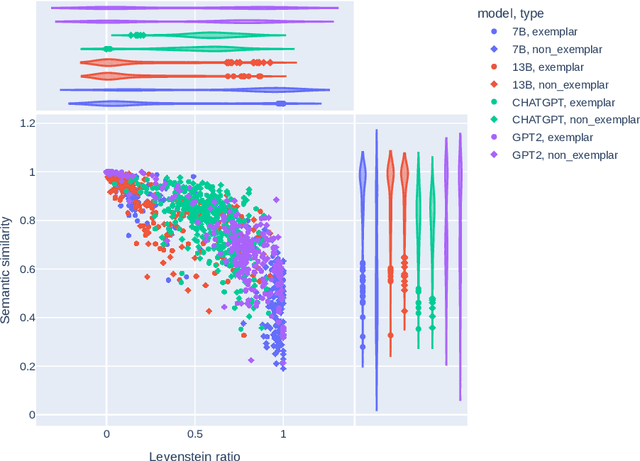

Abstract:Social media discourse involves people from different backgrounds, beliefs, and motives. Thus, often such discourse can devolve into toxic interactions. Generative Models, such as Llama and ChatGPT, have recently exploded in popularity due to their capabilities in zero-shot question-answering. Because these models are increasingly being used to ask questions of social significance, a crucial research question is whether they can understand social media dynamics. This work provides a critical analysis regarding generative LLM's ability to understand language and dynamics in social contexts, particularly considering cyberbullying and anti-cyberbullying (posts aimed at reducing cyberbullying) interactions. Specifically, we compare and contrast the capabilities of different large language models (LLMs) to understand three key aspects of social dynamics: language, directionality, and the occurrence of bullying/anti-bullying messages. We found that while fine-tuned LLMs exhibit promising results in some social media understanding tasks (understanding directionality), they presented mixed results in others (proper paraphrasing and bullying/anti-bullying detection). We also found that fine-tuning and prompt engineering mechanisms can have positive effects in some tasks. We believe that a understanding of LLM's capabilities is crucial to design future models that can be effectively used in social applications.
Different Horses for Different Courses: Comparing Bias Mitigation Algorithms in ML
Nov 19, 2024
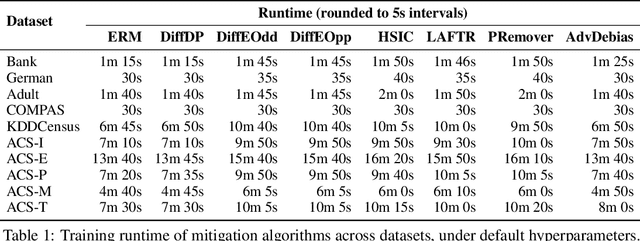


Abstract:With fairness concerns gaining significant attention in Machine Learning (ML), several bias mitigation techniques have been proposed, often compared against each other to find the best method. These benchmarking efforts tend to use a common setup for evaluation under the assumption that providing a uniform environment ensures a fair comparison. However, bias mitigation techniques are sensitive to hyperparameter choices, random seeds, feature selection, etc., meaning that comparison on just one setting can unfairly favour certain algorithms. In this work, we show significant variance in fairness achieved by several algorithms and the influence of the learning pipeline on fairness scores. We highlight that most bias mitigation techniques can achieve comparable performance, given the freedom to perform hyperparameter optimization, suggesting that the choice of the evaluation parameters-rather than the mitigation technique itself-can sometimes create the perceived superiority of one method over another. We hope our work encourages future research on how various choices in the lifecycle of developing an algorithm impact fairness, and trends that guide the selection of appropriate algorithms.
Towards Trustworthy Knowledge Graph Reasoning: An Uncertainty Aware Perspective
Oct 11, 2024Abstract:Recently, Knowledge Graphs (KGs) have been successfully coupled with Large Language Models (LLMs) to mitigate their hallucinations and enhance their reasoning capability, such as in KG-based retrieval-augmented frameworks. However, current KG-LLM frameworks lack rigorous uncertainty estimation, limiting their reliable deployment in high-stakes applications. Directly incorporating uncertainty quantification into KG-LLM frameworks presents challenges due to their complex architectures and the intricate interactions between the knowledge graph and language model components. To address this gap, we propose a new trustworthy KG-LLM framework, Uncertainty Aware Knowledge-Graph Reasoning (UAG), which incorporates uncertainty quantification into the KG-LLM framework. We design an uncertainty-aware multi-step reasoning framework that leverages conformal prediction to provide a theoretical guarantee on the prediction set. To manage the error rate of the multi-step process, we additionally introduce an error rate control module to adjust the error rate within the individual components. Extensive experiments show that our proposed UAG can achieve any pre-defined coverage rate while reducing the prediction set/interval size by 40% on average over the baselines.
 Add to Chrome
Add to Chrome Add to Firefox
Add to Firefox Add to Edge
Add to Edge